Phonics and Early Reading
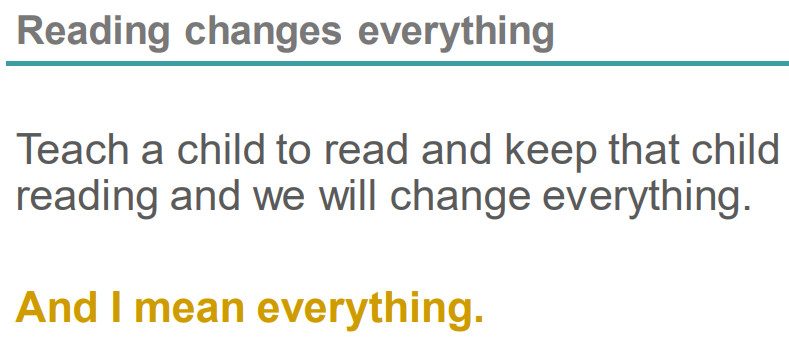
Phonics at Northenden Community School
At Northenden Community School, we aim for all our children to become fluent, confident readers who are passionate about reading.
Children who read regularly or are read to regularly have the opportunity to open the doors to so many different worlds!
More importantly, reading will give your child the tools to become independent life-long learners.
We can achieve this together through:
- Read Write Inc, a synthetic phonics program to help to your child read at school
- Encouraging children to develop a love of books by reading to them daily, at home and at school
- Giving children access to a wide range of books at school and at home
The Government strongly recommends the use of synthetic phonics when teaching early reading skills to children. Synthetic phonics is simply the ability to convert a letter or letter group into sounds that are then blended together into a word.
At Northenden Community School, we use the Read Write Inc. Phonics programme (RWI) to get children off to a flying start with their reading. RWI is a method of learning, based upon letter sounds and phonics, and we use it to aid children in their reading and writing.
What is Read Write Inc?
Read Write Inc (RWI) is a phonics programme which helps all children learn to read fluently and at speed so they can focus on developing their skills in comprehension, vocabulary and spelling. The programme is designed for children aged 4-7. However, at Northenden we begin to expose children in Nursery to skills that will help them access the taught programme in Reception. We continue teaching RWI to children beyond the age of 7, as we use a stage not age approach.
RWI was developed by Ruth Miskin and more information on this can be found at Parents - Ruth Miskin Literacy.
The five key principles that underpin all the teaching in all Read Write Inc. Programmes are:
- Participation – ensure every child participates throughout the lesson. Partnership work is fundamental to learning. Our teaching strategies ensure that all children participate fully in the whole lesson – there is no chance for children to lose concentration and miss key elements of the teaching
- Praise – ensure children are praised for effort and learning, not ability. Children work together, as partners, taking turns to teach and praise one another and they are motivated by the focused praise they receive from teachers and teaching assistants
- Pace – teach at an effective pace and devote every moment to teaching and learning. A lively pace keeps all the children fully engaged
- Purpose – know the purpose of every activity and share it with the children, so they know the one thing they should be thinking about. Teachers know the purpose of every activity and how it leads into the next
- Passion – be passionate about teaching so children can be engaged emotionally. It is easy for teachers to be passionate about their teaching because they see their children make such rapid progress.
How will my child be taught to read?
Pupils learn how to ‘read’ the sounds in words and how those sounds can be written down. This is essential for reading, but it also helps children learn to spell well. We teach the children simple ways of remembering these sounds and letters.
Reading
The children:
- Learn 44 sounds and the corresponding letters/letter groups using simple picture prompts – see below
- Learn to read words using Fred talk and sound blending
- Read from a range of storybooks and non-fictions books matched to their phonic knowledge
- Work well with partners
- Develop comprehension skills in stories by answering 'Find It' and 'Prove It' discussion questions
Writing
The children:
- Learn to write and form the letters/letter groups which represent the 44 sounds with the help of fun phrases
- Learn to write words by using Fred Talk
Talking
The children:
- Work in pairs so that they:
- Answer every question
- Practise every activity with their partner
- Take turns in talking and reading to each other
- Develop ambitious vocabulary
Progressing through the stages
Children in Early Years are introduced to initial sounds. Children then begin to learn how to 'read' the sound in words and how those sounds be can be written down. As children progress, they follow the same format as Early Years but will work on complex sounds and read books appropriate to their reading level. Children are assessed and grouped regularly according to their current ability.
As part of the programme the children have a daily phonic lesson and during this lesson they will have;
- Speed sound lesson – introduced to new sound and recap all sounds (Set 1, Set 2, Set 3 and Extra Sounds)
- Read Green Words (words that contain a new sound or a previously taught sound)
- Read Red Words (non-decodable high frequency words)
- Read Nonsense words (Alien Words - made up from all sounds)
- As well as learning t read and blend real words children will have plenty of opportunities to apply their sound recognition skills on reading ‘Nonsense words’. These words will also feature heavily in the Year One Phonics Screening check in the summer term.

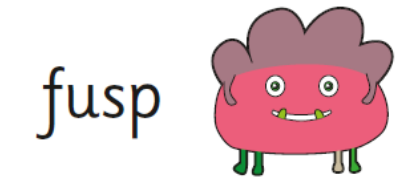

- Fred Finger Spelling
- Read phonetically decodable texts
Nursery
When appropriate, children will be introduced to the initial sounds in short sessions.
Reception
In Reception all children will learn how to ‘read’ the sounds in words and how those sounds can be written down. In the Autumn Term Reception pupils are taught separately to the rest of Key Stage 1.
Year One & Year Two
Children follow the same format as Reception but will work on complex sounds and read books appropriate to their reading level.
Fred Talk
We use pure sounds (‘m’ not’ muh’,’s’ not ‘suh’, etc.) so that your child will be able to blend the sounds into words more easily.
At school we use a puppet called Fred who is an expert on sounding out words!
We call it, ‘Fred Talk’. E.g. m-o-p, c-a-t, m-a-n, sh-o-p, b-l-a-ck.
The following video is an example of blending sounds with Fred. Click this link to see Fred talk in action.
All children will be taught how to read the following sounds:
Before you start to teach your child, practise saying the sounds. These are the sounds we use to speak in English. Click here for the pronunciation of the sounds.
The children are taught the sounds in 3 sets:
Set 1 Sounds are taught in the following order together with rhymes to help children form the letters correctly and instantly recognise sounds ready for blending.
These are the Set 1 Speed Sounds written with one letter:
m, a, s, d, t, i, n, p, g, o, c, k,
u, b, f, e, l, h, r, j, v, y, w, z, x
These are the sounds written with two letters (your child will call these ‘special friends’):
sh, th, ch, qu, ng, nk
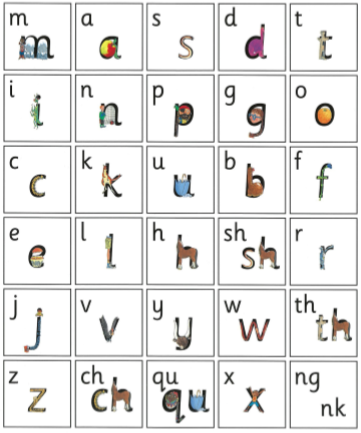
Set 2:
The children are then taught Set 2 Sounds - the long vowels.
These are the Set 2 Speed Sounds:
ay, ee, igh, ow, oo, oo,
ar, or, air, ir, ou, oy
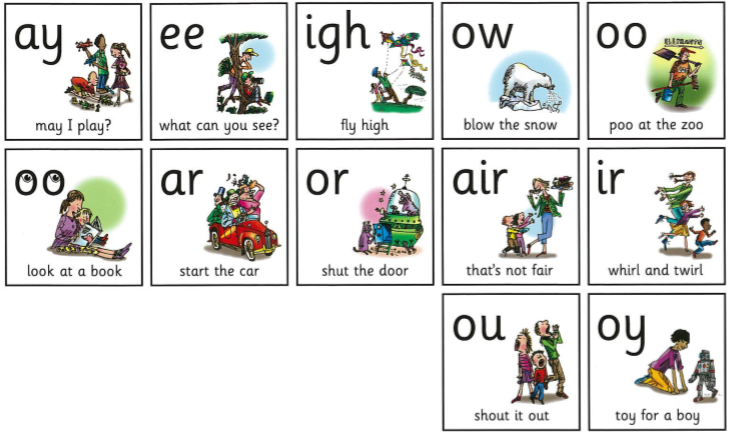
Set 3:
When pupils are very confident with all of set 1 and 2 they are taught Set 3 Sounds.
ea, oi, a-e, i-e, o-e, u-e,
aw, are, ur, er, ow, ai, oa, ew,
ire, ear, ure
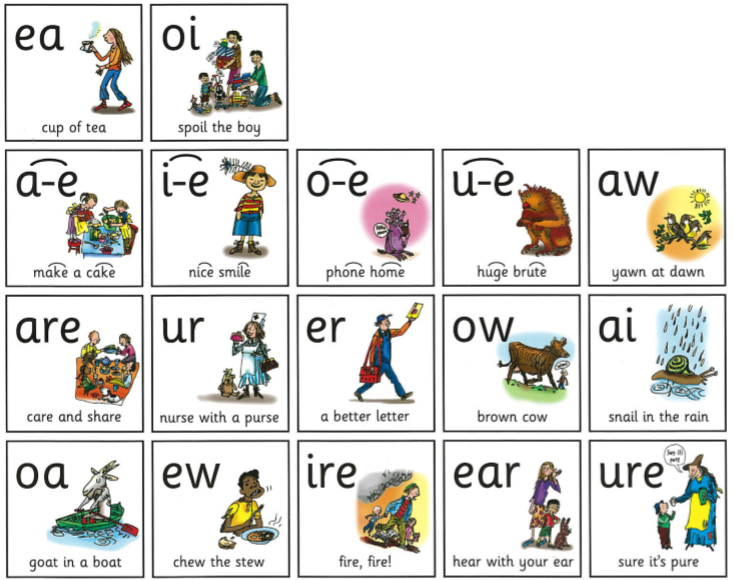
Additional Speed Sounds:
ue, ie, au, e-e, e, kn, ck, wh, ph
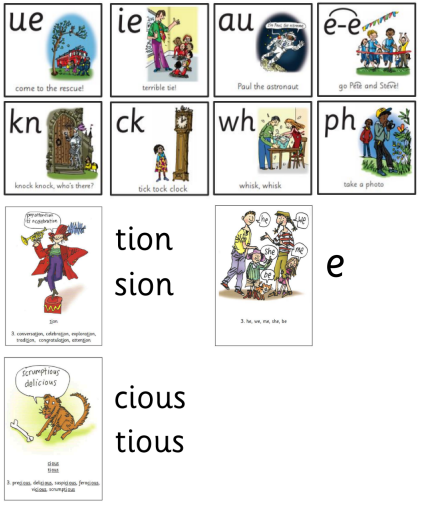
Progression through the RWI Scheme:
Once pupils begin to blend sounds together to read words they are sent home with 'sound blending' books. As their confidence in sound-blending and partner-practice grows, the children progress from reading words to reading captions in ditties.
Once your child is reading captions confidently they can access RWI storybooks. These longer texts require them to read sentences with partner-practice and complete associated tasks. The group will work on the same book over 3 to 5 lessons to ensure learning is embedded.
They will bring these home once they have read and discussed the book in class.
Expectations of progress
Our goal is for children to:
1. Work out unfamiliar words quickly – including new vocabulary and names.
2. Read familiar words speedily – that is, words they have been taught.
3. Read texts - including the words they have been taught – fluently.
All children should achieve these expectations, if they have followed the programme from Reception.
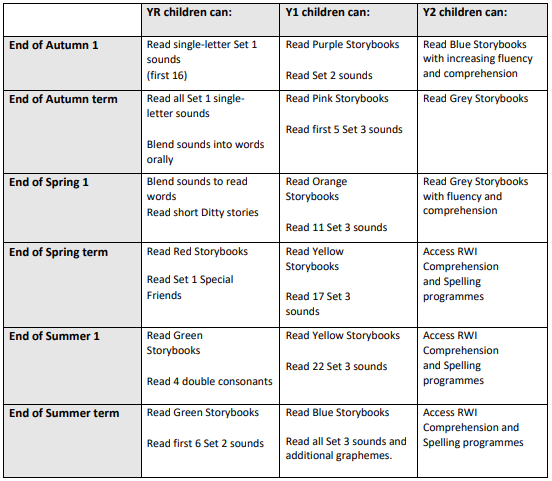
Within all the books children will have red and green words to learn to help them to become speedy readers. Red words are words that are not easily decodable and challenge words to extend children’s vocabulary. Green words are linked to the sounds they have been learning and are easily decodable.

Dots and dashes represent the sound each letter makes.
During the RWI session children will read the book three times and at each new reading they will have plenty of opportunities to practise using their developing comprehension skills.
To help at home:
Your child will initially bring home sound sheets and sound blending books. Your child will then be given ditties before progressing to books as they become more confident readers. Please help them to read and give lots of praise!
They will bring home a copy of the class text that they are familiar with as well as a ‘Book Bag’ book which matches the familiar text. Please read these frequently to ensure fluency and confidence.
Pupils in EYFS and KS1 will also bring home a library book that they have chosen themselves from the school library. This is a text for you to read to them.
If you have any other questions about RWI, please see your class teacher or Miss Lyons.
Phonics Screening Check Year One
What is the Year 1 phonics screening check?
The Year 1 phonics screening check is a short, light-touch assessment to confirm whether individual pupils have learnt phonic decoding to an appropriate standard.
It will identify the children who need extra help so they are given support by their school to improve their reading skills. They will then be able to retake the check so that schools can track pupils until they are able to decode. Pupils who do not pass the phonics screening check in Year 1 will have the opportunity to retake it in Year 2. The phonics screening check is always completed in June.
Further information can be found here.
Useful websites/links for Parents:
Please find a list of websites that you may find useful in helping you and your child learn about phonics. Games and fun activity websites are also included.
Websites:
- Oxford Owl - RWI Phonics: A guide for parents:
- Ruth Miskin - Information and resources to support phonics learning at home
- Early Years BBC Bitesize
- Key Stage 1 BBC Bitesize
- Key Stage 2 BBC Bitesize
- Phonics Play
- ICT Games
Apps:
- Hairy Phonics
Documents:
- Parent FAQs
- Parent Letter
- Simple Speed Sounds Chart
- Complex Speed Sounds Chart
- Set 1 Sounds
- Set 2 and 3 Sounds
- Top Tips for Reading